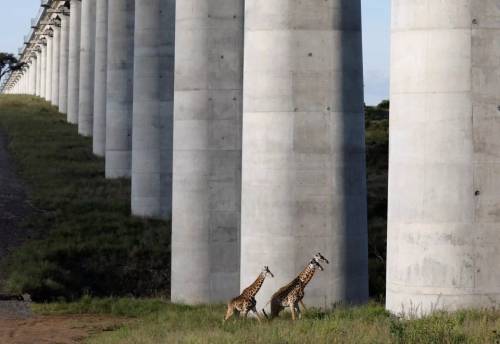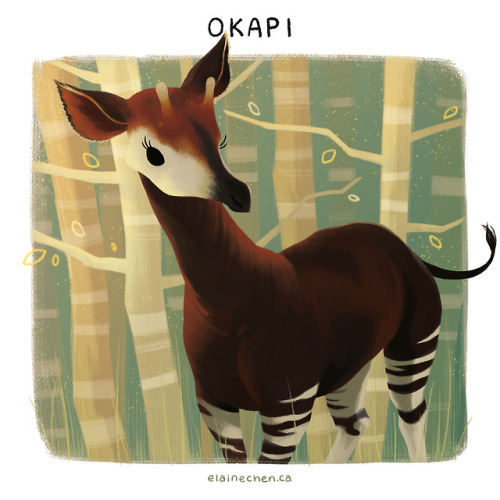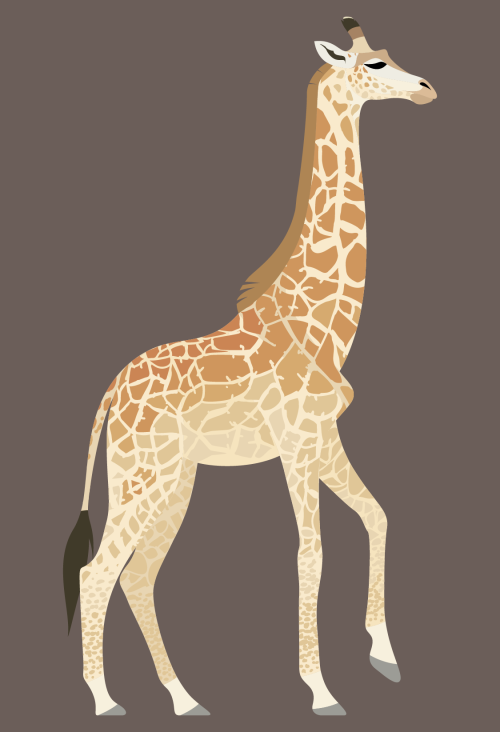#giraffidae
Maasai giraffes (Giraffa camelopardalis tippelskirchi) crossing under a bridge of the Standard Gauge Railway line, inside the Nairobi National Park.
Post link
OKAPI is one of the most beautiful and elusive animal species that was brought to the Western world’s knowledge in 1901. Appearing to be a mix between a giraffe, zebra and a horse, they are also known as the Forest Giraffe, or Zebra Giraffe. Their closest relative is the giraffe and the only surviving members of the Giraffidae family.
Even though they are about 6.5 feet tall and 8 feet long, closer to a horse than a giraffe, the shape of their body in the front and back is similar to the giraffe. Their tongue is also a similarity. Approximately 14 inches long, the okapi can use it to lick its eyelids and groom their upright ears!
One other interesting fact about these amazing animals, is that they were known in ancient Egypt! Carved images were found by excavators of the okapis. Let their beauty continue to be seen by generations to come=)
>TO BUY THIS PART OF 2019 CALENDAR CLICK HERE<
For more from this series >click here<
Post link
Sivatherium – Early Pliocene-Late Holocene (5-0.008 Ma)
Welcome back to Mammal Town! We’re talking about terrestrial animals again, and today’s featured landlubber is Sivatherium. The fun thing about Cenozoic mammals, especially when you get close to the current day, is that they tend to look generally similar to what we have today, but sometimes with a pinch of What the fuck. Sivatherium is a good example of that, and let’s talk about why:
Sivatherium lived very recently, maybe up to as recently as 8,000 years ago. Rock paintings of roughly that age have been found in India and the Sahara desert, and they look a whole lot like Sivatherium. As you can see, they were closely related to the giraffes and okapis of nowadays. Giraffids used to be a widespread, super diverse group before dwindling down to the two genera alive today. Sivatherium was like an okapi who spec’d hard into defensive traits. It was several feet taller and hella bulkier. It’s the largest giraffid known (even though giraffes are taller, they’re way more slender and lightly built, so they’re considered smaller), and maybe the biggest ruminant in the history of the universe.
Other than its size, the most defining features of Sivatherium are the pair of bone crests on its head. Sure, it has the classic giraffid forehead prongs, but also sported huge, heavy antlers. It must have had beefy shoulders, if it was going to be able to hold those antlers up. I want to be clear, this was an absolute unit of a giraffid. A built motherfucker.
This animal also has a bit of history to its research. When it was first classified in 1836, it was thought to be some kind of elephant. Then, it was thought to be something like a moose. While we were still figuring this guy out, it was generally thought that it had a fleshy trunk, or maybe a really prehensile lip, because the shape of its skull had room for muscles to move such a thing around. This idea was pretty much canned after we found out it was a giraffe cousin, though.
It’s generally assumed to have had a lip similar to giraffes and okapis because of a method called phylogenetic bracketing. What that means is, basically, we propose a trait in something extinct, usually something that doesn’t fossilize like a trunk. Then we look at its close relatives and ask, “Do they have it?” If the answer is “Yeah,” it’s pretty likely. If the answer is “Nah,” you can almost guarantee it’s not there. Since giraffes and okapis—both of which are REALLY close cousins to Sivatherium—don’t have a trunk or a really prehensile lip, it’s pretty likely it had a normal okapi face. And there’s nothing wrong with that. He’s still beautiful.
That’s a basic rundown of Sivatherium and… I guessan unplanned overview of phylogenetic bracketing. It’s always fun to see where these animals take me when I write about them. The next animal ought to be something much older, and maybe a little squishier. I don’t want to get too predictable here.
Post link








